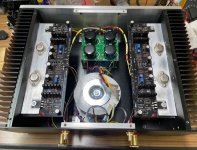A custom trafo will solve the problem...
What problem? NP says that the Vfet amp will work with voltages from 20 to 32 volts. I'm asking what the impact of using a lower than normal supply voltage would be. A supply like the ones normally used for the Aleph J and many other DIY Pass amps.
lower power, as first
sound-wise, even if resulting power is enough, said in simplest way - some loss of speed and grip
how much, can't say
all these parts like voltage
Thanks ZM. I don’t need the extra power, but perhaps I’m better off putting something else in with the Aleph J that uses the same power supply, like an F5. The chassis and heatsinks are big enough so that two circuit boards and their devices can be placed near the middle of each one. Each heatsink is about 13” by 17”. If the Vfet amp will indeed suffer from having a 24 Volt rather than a 28 volt B+ voltage, then there is no point putting it in with the AlepH J.
Hi All.
I have a DIY Aleph J project that has very large heat sinks that will accommodate both the Aleph J PCBs and the Sony Vfet PCBs attached to their L brackets.
I would like to install both amps into the same chassis, and have a switch so that I can use one or the other. This entails sharing a power supply that has a common Antek AN-5218 18V-18V 500 VA transformer.
I did this with an F5 and M2x. It worked very well. I used a bi-color LED on the front panel to indicate which amp was in use, and a 4 pole switch on the back to change power and output connections.
why you post ??
I posted to ask what the impact of using a lower than normal supply voltage would be. That’s why I posted. ZM kindly answered the question. If anyone else who is operating their Vfet amp at lower voltages has observations, I would love to hear them. Buying a completely different power transformer with multiple taps, using a separate power transformer for each circuit, and building two completely separate amps, are all obvious ways to getting the right voltage to the Vfet amp, but I didn’t ask about that. I asked what would happen to output power and sound quality if I used the same 18V-18V power transformer, which I already own, for both circuits. That is what I asked in my original post in this thread and why I posted.
I did this with an F5 and M2x. It worked very well. I used a bi-color LED on the front panel to indicate which amp was in use, and a 4 pole switch on the back to change power and output connections.
grendel23: This is what I would like to do, but the Vfet amp normally uses a 22V-22V transformer instead of the 18V-18V used by most of the Pass DIY amps. I have lots of room on the heatsinks, so I will probably place the Aleph J boards in a way that will allow me to also install another Pass amp into the chassis. I just need to figure out which one. I don’t want to hobble the Vfet amp, so I will probably build it in its own chassis in the future.
rarity of parts and complexity of circuit/entire project, same as final sound quality - all that justifies investment in proper hardware and making proper dedicated amp
having one good amp in one system is enough
having two alternating amps in one system is called greediness
so, paying fully for your own greediness is just, and also give you more facts for later boasting
having one good amp in one system is enough
having two alternating amps in one system is called greediness
so, paying fully for your own greediness is just, and also give you more facts for later boasting

rarity of parts and complexity of circuit/entire project, same as final sound quality - all that justifies investment in proper hardware and making proper dedicated amp
having one good amp in one system is enough
having two alternating amps in one system is called greediness
so, paying fully for your own greediness is just, and also give you more facts for later boasting
These are all good points. I admit it, I'm greedy.
Hi All.
I'm putting together the parts for my Vfet build, and I have a few quick questions.
Do the FQP3P20 and FQP3N30 need to be matched?
Do the ZTX450 and the ZTX550 need to be matched?
Is it okay to use TL431ACZT instead of TL431ACLPR?
Edit: Always buy the full kit from the DIY Audio store. Sourcing parts after the fact is very annoying.
I'm putting together the parts for my Vfet build, and I have a few quick questions.
Do the FQP3P20 and FQP3N30 need to be matched?
Do the ZTX450 and the ZTX550 need to be matched?
Is it okay to use TL431ACZT instead of TL431ACLPR?
Edit: Always buy the full kit from the DIY Audio store. Sourcing parts after the fact is very annoying.
No matching needed for the parts you mentioned. With the Fairchilds, you probably
will want to use 1K pots for P3 and P4 to account for their higher Vgs.
It's ok to use TL431ACZT.
Thanks Dennis!
Sony VFET amp
First amp I have the complete built in years. Thanks to WFH.
I want to express my full gratitude to Nelson Pass for his generosity and constant contributions to the diyaudio community. Thanks for this special gift.
The amp very well behaves. There’s very little dc drift. The bias stays constant. And it sounds really great. This amp is special.
First amp I have the complete built in years. Thanks to WFH.
I want to express my full gratitude to Nelson Pass for his generosity and constant contributions to the diyaudio community. Thanks for this special gift.

The amp very well behaves. There’s very little dc drift. The bias stays constant. And it sounds really great. This amp is special.

Attachments
During the height of the pandemic last year, a couple friends living across the country and I decided to have a virtual group build project using weekly scheduled Zoom meetings to build Mr. Pass’ Aleph J design. Having built a Pass DIY Sony VFET amp using complementary pairs of the Sony VFETs two years prior, I was able to lend some guidance to my friends in building their Aleph J amps, and everyone had a great time talking all things music and audio while we all lived in isolation. We are all now huge fans of the Aleph J amp and listen to them in our systems.
In my living room, I have a second system using a Raspberry Pi 4 running Volumio as my digital streaming source. This feeds a modest Encore mDSD USB DAC that is connected to a Pass DIY B1 Korg NuTube line stage, an inexpensive, modified Aiyima A04 TI TPA3251-based Class D amp and my KEF LS50 speakers. A couple weeks ago, I loaned my Aiyima amp to a friend, so I decided to install my Pass DIY Sony VFET amp in this system. I had used this amp with the KEF LS50’s before in a smaller living room arrangement. When I connected the Sony VFET amp to my system in a much larger space, I was floored by the ability of this amp to drive the 84-85dB sensitive KEF’s to room-filling volumes. I am getting floor shaking bass from this amp rated for 15W at 8 ohms and 20W at 4 ohms. The LS50’s have a nominal impedance of 8 ohms, but can dip as low as 3 ohms.
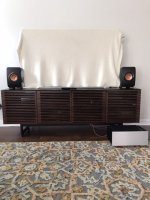
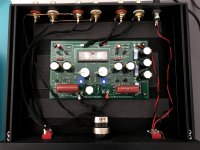
Anecdotally, I would not expect a 15 watt power amp to be able to drive KEF LS50’s to 85+ dB SPL with a clean, distortion-free and totally rich sound. Since I didn’t win the lottery for the latest round of single ended Sony VFET kits, I was contemplating on repurposing these Sony VFETs and get the kits to build two single ended amps. However, I am getting so much listening enjoyment out of this complementary VFET pair amp so much, I’ll stay the course with this build.
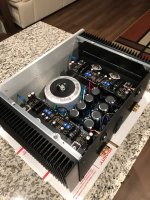
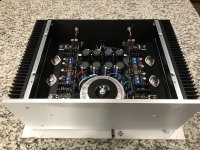
I am curious as to how this amp manages to drive these loudspeakers with ease.
In my living room, I have a second system using a Raspberry Pi 4 running Volumio as my digital streaming source. This feeds a modest Encore mDSD USB DAC that is connected to a Pass DIY B1 Korg NuTube line stage, an inexpensive, modified Aiyima A04 TI TPA3251-based Class D amp and my KEF LS50 speakers. A couple weeks ago, I loaned my Aiyima amp to a friend, so I decided to install my Pass DIY Sony VFET amp in this system. I had used this amp with the KEF LS50’s before in a smaller living room arrangement. When I connected the Sony VFET amp to my system in a much larger space, I was floored by the ability of this amp to drive the 84-85dB sensitive KEF’s to room-filling volumes. I am getting floor shaking bass from this amp rated for 15W at 8 ohms and 20W at 4 ohms. The LS50’s have a nominal impedance of 8 ohms, but can dip as low as 3 ohms.


Anecdotally, I would not expect a 15 watt power amp to be able to drive KEF LS50’s to 85+ dB SPL with a clean, distortion-free and totally rich sound. Since I didn’t win the lottery for the latest round of single ended Sony VFET kits, I was contemplating on repurposing these Sony VFETs and get the kits to build two single ended amps. However, I am getting so much listening enjoyment out of this complementary VFET pair amp so much, I’ll stay the course with this build.


I am curious as to how this amp manages to drive these loudspeakers with ease.
Last edited:
Anecdotally, I would not expect a 15 watt power amp to be able to drive KEF LS50’s to 85+ dB SPL with a clean, distortion-free and totally rich sound. Since I didn’t win the lottery for the latest round of single ended Sony VFET kits, I was contemplating on repurposing these Sony VFETs and get the kits to build two single ended amps. However, I am getting so much listening enjoyment out of this complementary VFET pair amp so much, I’ll stay the course with this build.
DON'T DO IT! I've built the recent DIY Sony VFet 'single ended' from the lottery and had evaluated it for a good month of hard listening. They are not even close to the sound of my CSX1 I built last year. If you value SLAM and detailed bass and control, your CSX2 is going to be the better bet.
Yes i'm pushing over 36 volt rails on mine with a hefty linear power supply. There is no comparison to the kit single ended version VFet and i'm uncertain if that is due to the nature of the kit using a SMPS or the Linear Systems JFets that came with the kit. I do know my CSX1 in single ended using the Toshiba JFets still sounded way better. Ultimately, I went back to balanced gear and done away with any input buffer by going direct to the input transformer. (note the CSX2 does not have the input transformer so my CSX1 would be more comparable to the DIY single ended VFet lottery kit).
The VFet SE lottery kit is rated around 8 watts per channel but I can easily make it clip and distort at higher SPLs. However in comparison my CSX1 seems to be way cleaner and way louder. The bass at high SPLs is something to be raved about and i'm saying on an order of maybe 4 or 5 times louder (ie car audio deafness). This is strange because in consumer gear, there's usually very little difference in 'perceived' loudness at high SPLs between a 40 watt amp vs an 80 watt amp. (unless everyone is measuring RMS wattage output in a different way).
Thanks Super_BQ. With the Sony VFET amp, I feel like I have something like a push-pull 300B amp that is well able to drive my somewhat inefficient KEF speakers with ease. The pairing of this amp with the B1 Korg NuTube line stage is very musical and smooth. The soundstage is huge and deep belying the size of the KEF LS50’s.
With my other system, I have a pair of Klipsch Forte II’s, which should be a better load for single ended amps like the new DIY Sony VFET amp. I bought a pair of matched Tokin THF-51S SIT’s for a future single ended SIT amp project.
With my other system, I have a pair of Klipsch Forte II’s, which should be a better load for single ended amps like the new DIY Sony VFET amp. I bought a pair of matched Tokin THF-51S SIT’s for a future single ended SIT amp project.
Since I didn’t win the lottery for the latest round of single ended Sony VFET kits, I was contemplating on repurposing these Sony VFETs and get the kits to build two single ended amps.
That would be the worst of all possible ways to get the VFET parts to build a lottery amp. No matter what you do, don't mess with your push-pull Sony VFET amp!
If you need parts to make a lottery SE amp, ask around for parts. They are out there. I think I've seen some floating around on my workbench, not far from my curve tracer... I'd be more than happy to trade these for your your push-pull Sony VFET
Last edited:
- Home
- Amplifiers
- Pass Labs
- Sony vFET Illustrated build guide
